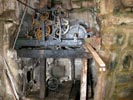|
|
| The
Clock Tower of Ribadavia |
The
neoclassical design on the front is dated from the XIX century.
The chronicler Murguía wrote about ‘the church door,
in is renaissance, the beautiful and curious clock belfry, an iron
tiller, all rich and dine to conserve’. On the arch of the
door which enters to the clock tower are the arms of the Sarmiento
of Ribadavia. As Vicente Risco wrote, it has a very interesting
side stairway, with three parts superimposed on one another: below,
a door with an arch, in the second a shield displaying the coat
of arms (one in white and one with a sun and a moon above a castle
and with a picture of a wave) and in the third a window and a sundial.
It was constructed in the decade following 1545. History records
that the people in charge of the construction were the expert stonemason
Pedro Gómez and the carpenters Juan Leal and Esteban González..
|
|
|
|
|
 |
In the October of this 1545 the procurer, the General of the Town
and jeweller Glau de Mosquera, delivered a quote to the stonemason;
‘I pay of the House of the Regiment, said Pedro González,
twenty dukedoms’. In the year of 1781 the town Council meeting
of the 19 April pledged to finish the foundation of the public clock
and to inscribe on its bell “Verbum caro Factum est. Xptus.
Vincit. Xptus. Regnat. Xptus. Ymperat. Xptus. Ab omni malo nos diferendat’
.
A new mechanism for the clock was later obtained by agreement of
the Council of 1883. It was sold later, in 1902, to a private buyer
for 17 pesetas and the mechanism was replaced by the present mechanism.
|
 |
To work the
clock, the rope has to be tugged every day. This rope is provide
with a wheel with a handle in two parts: one for the hours and the
other for the half-hours. The handle for half-hours is comprised
by 12 turns and for hours, 142 turns. The person in charge has to
work and maintain it – currently Javier Fernández Casas
– who has taken more than 36 years without missing a single
day of work. |
|